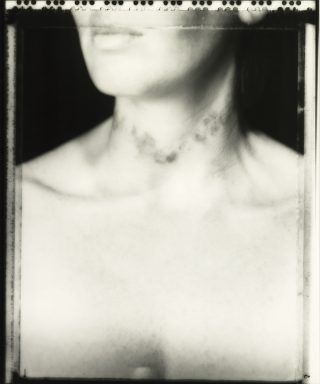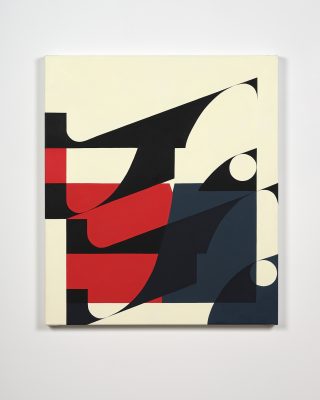Robert Fraser’s Morning/Homework Town brings together two distinct bodies of work: Morning, a group of three square-format paintings with a central motif evocative of a box, and Homework Town, a series of nine smaller rectangular works that feature band forms derived from the width of the masking tape habitually used by the artist. At first blush, the paintings seem easy to locate, to grasp. They make no bones about declaring their debt to mid-20th century hard-edge geometric abstraction, showing much of the orderliness and poise associated with that tradition. Aspects of Fraser’s process are regulated, subject to relatively tight parameters. His forms are strictly rectilinear. He will allow himself a quiet diagonal but not a curve. His compositions are spare, almost minimal. They are distilled to the essential, never over the top.
While sharing its elegance, Fraser’s work tends away from the cool, detached quality of much hard-edge painting (think, for instance, of canvases by Gordon Walters). The artist reaches back further, favouring the oil paint used by forerunners like Piet Mondrian and Kazimir Malevich, admitting the presence of the brush-mark, albeit one that is minimally expressive because predictably vertical. The formal composure of his paintings is counteracted by an uncommonly bold and varied use of colour. He won’t sit still, now playing with several tones of a single bright hue (Resonating Bell), now trying a muted and harmonious arrangement (Homework Town), now plumping for high contrast, even discord (The Slowest Thing You Do (Consciously)). No one formula applies to all works. Individual paintings are strongly individuated; the exhibition as a whole acquires an air of vital contingency.

Robert Fraser, Controversy Corner, 2018. Image courtesy of the artist.
Fraser’s process also involves uncertainty, challenging the obsessive planning and perfection that characterises so much geometric abstraction. The artist not only allows for chance effects, but actively welcomes them, engineering what he calls ‘accidents on purpose’. His preference for oil paint is one source of aberrations. Used in combination with masking tape, oil creates edges that are sharp when viewed at a distance yet reveal their physicality up close. Small ridges emerge. These are not the neat, plasticky ridges associated with acrylic (as seen, for instance, in the later Lattice paintings of Ian Scott), but slightly fuzzy, bleeding lines, which offset the overall impression of immaculateness. The artist embraces the medium’s propensity to smear, to misbehave, to resist his control, and thereby eschews enervation.
Fraser’s compositions are seldom predetermined. He tends to avoid planning. While a few works quickly announce themselves resolved, others undergo considerable reworking. Fraser is not cagey about revealing this process. Like Henri Matisse before him, he has been known to document the development of his works in photographs. His Instagram features earlier versions of several of the paintings in Homework Town, revealing the extent to which the series derives from an intuitive process of revision. The works themselves also bear witness to the alla prima mode of making. Pentimenti ghost the images, not emerging through thinning paint over time, but apparent straight away as raised lines faulting the surfaces—veins that attest to the life blood pumping away beneath the skin.

Robert Fraser, I’m Dead, 2018. Image courtesy of the artist.
The Homework Town paintings are united by a particularly strong sense of design, being reminiscent of mock-ups for book covers, company logos, or flags. A couple include slot-like elements, but, otherwise, little interest is shown in fictive space. The emphasis is instead on the interplay between apparent flatness and actual—if subtle—texture. At times, the works feel like straightforward formal exercises; at others, like signs that are presently unintelligible but that could be decoded if one could just spend enough time considering them. Fraser’s titles only intensify the quality of ambivalence, reading, by turns, like plain descriptions of forms in the works (Temple Gold), and like indirect allusions to phenomena known only to the artist, which coloured the painting process or emerged during same (I’m Dead, Baleful Infection).
Morning represents a markedly different series; Fraser notes that it speaks the same formal language but in a distinct dialect. The illusionistic box forms immediately tie the three works together. Hovering in void space, they feel enormous and otherworldly. At the same time, the paintings are overtly tethered to the real. Morning Again resonates strongly with the atmosphere of early morning, the light of a new day prising apart old dark. As its title indicates, Morning Bunnings was suggested by a Bunnings Warehouse, specifically a branch built near the artist’s home in the Tāmaki Makaurau suburb of Grey Lynn and seen by him regularly on the way to work. The painting is witty, even funny, picking up on the forms and colours of the franchise’s logo, as well as evoking the notion of the ‘big box’ store more generally.

Robert Fraser, Morning Bunnings, 2018. Image courtesy of the artist.
The appearance of Bunnings in Grey Lynn was not universally celebrated by people in the area. Some viewed the unglamorously uniform building as a blight on their elegant and expensive suburb, while others saw it as a marker of the neighbourhood’s decisive transformation into just such a suburb—one well on the way to being renovated beyond recognition. Morning Heat Seekers similarly gestures towards questions of housing and class, ‘Heat Seekers’ being the name of a business that offers both thermal imaging (used to identify structural issues in houses) and meth testing. The expression is also used to describe people sometimes seen in the early hours of the morning, searching for—in the artist’s description—‘a last drink, or something harder, before they face the inevitable and go home’.
Fraser’s works do not offer a particular position, but they cue reflection on the states of affairs playing out beyond their elegant bounds. By invoking the particular place, time, and socio-political reality in which he lives and makes, the artist underscores his broader interest in texturing the tradition of geometric abstraction, developing a practice that retains the transcendence favoured by the likes of Malevich and Mondrian but is also distinctly ‘down to earth’. The paintings wittingly collide characteristics often thought of as separate and maintained as such. They are balanced and precarious, resolved and in process, poetic and prosaic. Fraser does not allow one quality to outdo or eclipse the other, instead encouraging them to exist, to be perceived, to be felt all together, at once.
*
Essay commissioned by Robert Fraser to accompany the exhibition Morning/Homework Town.
Morning/Homework Town
Robert Fraser
4 to 21 July 2018
Green Street Projects
Te Whanganui a Tara Wellington




